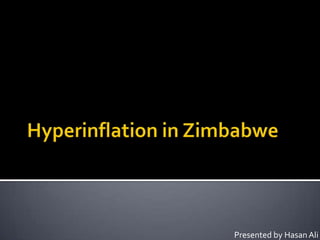Hyperinflation in zimbabwe
- 2.  What is Hyperinflation ?  What exactly happened in Zimbabwe  What's the way out
- 3.  In economics, hyperinflation occurs when a country experiences very high and usually accelerating rates of inflation, causing the population to minimize their holdings of money.  Meanwhile, the real value of economic items generally stay the same with respect to one another, and remain relatively stable in terms of foreign currencies.
- 4.  Unlike regular inflation, where the process of rising prices is protracted and not generally noticeable except by studying past market prices, hyperinflation sees a rapid and continuing increase prices and in the supply of money,and the cost of goods.  Hyperinflation is often associated with wars, their aftermath, sociopolitical upheavals, or other crises that make it difficult for the government to tax the population, as a sudden and sharp decrease in tax revenue coupled with a strong effort to maintain the status quo can be a direct trigger of hyperinflation.
- 5.  Confidence Model - In this model, some event, or series of events, such as defeats in battle removes the belief that the authority (a bank or a government) issuing the money will remain solvent. Because people do not want to hold notes which may become valueless, they want to spend them.  Monetary Model - In this model, hyperinflation is a positive feedback cycle of rapid monetary expansion. When businesspeople perceive that the issuer is committed to a policy of rapid currency expansion, they mark up prices to cover the expected decay in the currency's value.
- 7.  Highest inflation rate – November 2008 - 7.96 × 1010 %  Equivalent daily inflation rate - 98.01%  Time required for prices to double - 24.7 hours
- 8.  30 years ago – ZWD = 1.25 USD  Gradually, rampant inflation and collapse of the economy devalued the currency.  Hyperinflation took shape in early 21st century  2004 - 624%  2006 - 1,730%  June 2007- 11,000%  July 2008 – 2,200,000%  The First Zimbabwe Dollar (ZWD) is obsolete. In June 2006, it was replaced by the Second Zimbabwe Dollar (ZWN) at a rate of 1000 to 1. A third and fourth dollar were later introduced and then the currency was abandoned.  Zimbabwe no longer has its own currency and Zimbabwe dollars of all types are worthless.  1 ZWD = 0.00276 USD (today !)
- 9.  Land reform program – focused on taking land from white farmers and redistributing those properties and assets to black farmers.  Food production and revenues from export of food plummeted  Monetary phenomena (the result of Mugabe's government printing money)
- 10.  No functioning Central Bank and no local currency  Stores don’t have food on shelves  People are hungry  No water, no electricity  Prices rise daily “Imagine, you cannot even carry the exact bus fare on your way to work because the chances are high that you will be told fares have gone up; you can't even make budgets for household commodities, as used to be the case seven or so years ago."
- 11.  Use of foreign currencies  The black market  Redenomination
- 12.  The most direct solution is a credible promise to stop printing unlimited amounts of money.  The government could declare some foreign currency to be the nation's official currency.  Formation of the inclusive Government and the liberalization of the economy.
Editor's Notes
- #4: Ex:For India while buying vegetables, the vendor quotes the rate of 1$ a kg rather than in rupees as that is a more stable way of dealing or receiving the money.
- #5: Ex: The cost of bread today is Rs. 25 for a 400gms packet, which was Rs. 20 around 2 years back. If this becomes 35-40 in the next month it becomes a case of hyperinflation.












